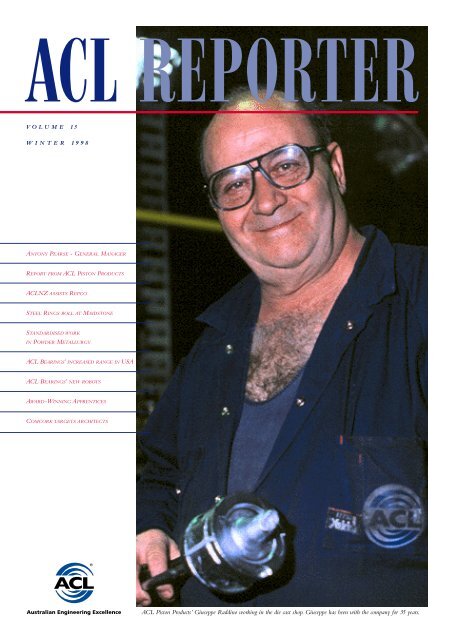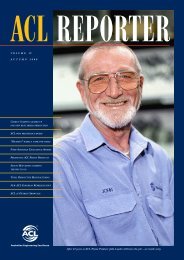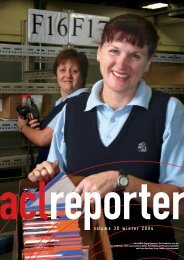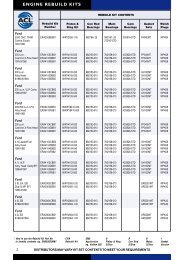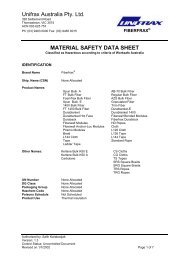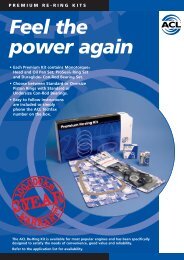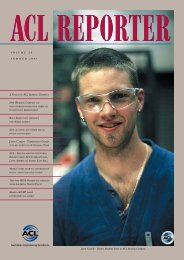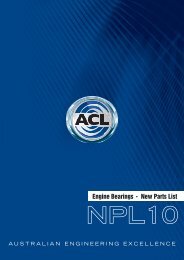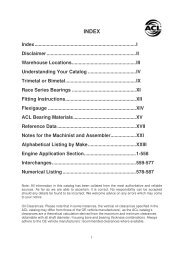ACL REPORTER
ACL Newsletter Issue 15.pdf
ACL Newsletter Issue 15.pdf
- No tags were found...
You also want an ePaper? Increase the reach of your titles
YUMPU automatically turns print PDFs into web optimized ePapers that Google loves.
<strong>ACL</strong> <strong>REPORTER</strong><br />
VOLUME 15<br />
WINTER 1998<br />
ANTONY PEARSE - GENERAL MANAGER<br />
REPORT FROM <strong>ACL</strong> PISTON PRODUCTS<br />
<strong>ACL</strong>NZ ASSISTS REPCO<br />
STEEL RINGS ROLL AT MAIDSTONE<br />
STANDARDISED WORK<br />
IN POWDER METALLURGY<br />
<strong>ACL</strong> BEARINGS’ INCREASED RANGE IN USA<br />
<strong>ACL</strong> BEARINGS’ NEW ROBOTS<br />
AWARD -WINNING APPRENTICES<br />
COMCORK TARGETS ARCHITECTS<br />
®<br />
Australian Engineering Excellence<br />
<strong>ACL</strong> Piston Products’ Giuseppe Raddino working in the die cast shop. Giuseppe has been with the company for 35 years.
LOADS OF GLOBAL<br />
OPPORTUNITIES<br />
Antony Pearse, General Manager <strong>ACL</strong> International, was one of the team of nine<br />
who formed the management group involved in the buy-out of Repco 12 years ago.<br />
With nearly 25 years in the business, he has seen many changes over that period.<br />
“Although there have been major<br />
changes in the market - increasing competition,<br />
higher levels of information - I think<br />
that the enormous investment we are now<br />
making in our own plants will have the<br />
greatest impact on our business,” he says.<br />
“Our competitive edge lies in several<br />
areas - we are a world-class quality operation<br />
(all major manufacturing operations are<br />
certified to ISO9001), and we are competitive<br />
on price and competitive on delivery.<br />
Compared to our larger opposition, we are<br />
friendlier and more able to tailor a solution<br />
Repco is ACNZL’s largest customer, and<br />
has seventy-five branches throughout<br />
New Zealand.<br />
When these branches receive telephone<br />
enquiries the calls are diverted to a Repco<br />
Telephone Room.The North Island Telephone<br />
Room consists of 45 staff,and is known<br />
as “Branch 45”.<br />
The South Island operation is set up in<br />
to a particular customer’s needs.”<br />
Antony spent six years in the United<br />
States and notes the importance of the US<br />
connection (<strong>ACL</strong> America holds the No 3<br />
position in the US engine bearing market),in<br />
providing an entrée to other world markets,<br />
Latin America especially.<br />
“The great thing about America is its<br />
national pride, but here in Australia I believe<br />
we are developing a more positive view about<br />
our own nation,and becoming more serviceoriented.Communication<br />
is playing a stronger<br />
role in the service model, too, and we are<br />
ACNZL ASSISTS<br />
REPCO WITH A<br />
LITTLE PRODUCT<br />
KNOWLEDGE<br />
Left to right Mohammed Sahid,<br />
Darryl Dixon, John Routen (ACNZL),<br />
Jason Greenwood and Tristan Adams.<br />
Christchurch and is manned by a staff of 20.<br />
These centres are open for business from<br />
7.30am to 6.00pm seven days a week. At<br />
Branch 45, regular staff training is the order<br />
of the day. In fact, this occurs every day for<br />
selected staff, and runs from 8 - 8.30am.<br />
Recently ACNZL was called in by Repco to<br />
top up their <strong>ACL</strong> product knowledge. Every<br />
morning for a week John Routen, Product<br />
now communicating with our customers<br />
increasingly via email and the Internet.<br />
Doing business this way is faster and more<br />
efficient,” he notes.<br />
Of course,being part of a global market,<br />
events in other countries can impact upon<br />
<strong>ACL</strong>’s business. “The Indonesian situation<br />
has affected us the most, causing us to retain<br />
stock we would have preferred to sell. On<br />
the positive side, however, that situation has<br />
caused us to move beyond our traditional<br />
Asian markets.For example,we are developing<br />
sales opportunities in Vietnam, Thailand,<br />
Bangladesh and the Philippines.Three or four<br />
years of laying groundwork in China is also<br />
starting to pay off.”<br />
It is pleasing that business in South<br />
Africa is picking up again after a short lull.<br />
<strong>ACL</strong> intends to focus increasingly on Europe.<br />
Large engine rebuilding plants in Central<br />
Europe may be the way into these potentially<br />
lucrative markets.<br />
“Long term, I also believe there is sales<br />
potential for us in the Middle East, although<br />
the current weakness of the yen is making it<br />
difficult for us to compete against Japanese<br />
manufacturers,”said Antony.Overall, Antony<br />
stresses that there are excellent international<br />
export opportunities for <strong>ACL</strong>.<br />
“I want to expand our markets for pistons,<br />
rings and gaskets,while continuing to build on<br />
the solid export base we have in bearings. And,<br />
on the back of that, identify other markets<br />
and match them to particular products.We<br />
have often been successful in finding a<br />
particular part with a reasonable volume -<br />
piston ring, bearings, gasket or whatever -<br />
then marketing that part competitively. In<br />
those situations, that may be all that the<br />
customer wishes to buy from us.The main<br />
thing is to keep looking for opportunities<br />
in which we can satisfy customer needs -<br />
big or small.<br />
Engineer at ACNZL, held training sessions.<br />
The obvious subject of pistons,gaskets,<br />
and bearings was rounded off with a demonstration<br />
of the gasket clamping load measuring<br />
equipment (see photo). This equipment has<br />
been used at many trade evenings throughout<br />
New Zealand.<br />
Further training took place during July<br />
in the South Island Telephone Room.
R E P O R T F R O M A C L P I S T O N P R O D U C T S<br />
STEEL RINGS READY TO<br />
ROLL AT MAIDSTONE<br />
Colin McDonald, left, with Kon Archon standing in front of the module<br />
According to Colin McDonald, steel rings pushed Piston Products into overdrive.<br />
have been around for many years. He said to date they would have spent<br />
“Basically, they were used in heavy duty more than $750,000 on new equipment, new<br />
diesel applications in the past, and with the processes, and training to get the company<br />
new design in engines, pistons are having ready for full production in August ’98.<br />
their top groove pushed up so far in the “We had to look for a contractor who<br />
compression area, that they’re required could do the heat treatment for the nitriding,<br />
now to have a ring that can withstand the and currently we use a salt bath process which<br />
temperatures and combustion,” said Colin. is a very robust process,” explained Colin.<br />
The answer lay in steel rings, which underwent<br />
a nitride heat treatment process that great deal of support was also forthcoming<br />
While Colin headed up the project, a<br />
gave the finished product a tougher surface from the production, maintenance and engineering<br />
people on site.“Kon Archon was a<br />
to handle the new extremes.<br />
Colin said the company started looking tremendous help,”said Colin,“and most of the<br />
at steel rings back in 1994 but it wasn’t until equipment we now have was built outside.<br />
1995 when Ford revealed their plans for a We’ve also purchased equipment from overseas<br />
new engine for the end of the century, and with one grinder costing around $500,000.<br />
requiring new steel nitride rings, that really The main machine in the module, is called<br />
NEW PISTON LINE<br />
FULLY INTEGRATED<br />
The new piston line that will Project Manager, Simon Parker, said that<br />
the new piston program,which required<br />
manufacture pistons for the Ford<br />
new phosphate and skirt coating equipment,<br />
Falcon 1990X, has now been fully was first started back in 1996 when the division<br />
integrated into <strong>ACL</strong> Piston Products’ needed to tool up for the new product.<br />
production system.<br />
“The equipment was bought and installed<br />
and trials were made in 1997. We had deadlines<br />
to meet from Ford for samples, as they<br />
wanted also to trial the finished product,”<br />
said Simon.“The issue was how could this<br />
new equipment support our high volume<br />
production line? So we went from a manufacturing<br />
line to a fully integrated process<br />
line. The manufacturing line was turning<br />
out a piston every 12 seconds, so the new<br />
phosphate line had to match that speed.”<br />
The new equipment was integrated<br />
The new skirt coating<br />
without incurring extra labour costs, utilising<br />
the existing automatic off load machine.<br />
a steel coiling machine, and this was built<br />
by a local machine builder, Invetech and<br />
Kon did a lot of work with this builder in<br />
the development stage,” said Colin.<br />
The steel ring module consists of a<br />
coiling machine, a wind down machine, a<br />
slitting machine, a loading machine, a heat<br />
form oven and a gapping machine.The front<br />
end of the process is the module,which integrates<br />
with the rest of the production in the<br />
workshop. “Half-way through the process<br />
we send the rings out for nitriding, and this<br />
must be integrated into our production flow,”<br />
said Colin. Extensive trials have been undertaken<br />
with full production expected to take<br />
place in August.<br />
The $500,000 grinder<br />
especially purchased for the process.<br />
The line fully integrated into the production schedule.<br />
Instead of off loading the piston onto a peg,<br />
it loaded it onto overhead hangers.<br />
Over Christmas, the company installed<br />
the new line with due regard for existing<br />
manufactured products while integrating the<br />
new equipment.“The equipment and control<br />
was such that we could still run and supply<br />
existing orders for pistons until such time as<br />
we started ramping up in proper volumes,”<br />
said Simon.<br />
Some $1.3 million has been spent to<br />
ready the division for full production in the<br />
areas of new pistons and rings for the next<br />
generation of Falcons.
R E P O R T F R O M A C L P I S T O N P R O D U C T S<br />
From left Robert Edwards, Lyha Tu, Colleen Lawson., Robert Tetkowski, and<br />
warehouse Group Leader, Russell Flanders.<br />
WAREHOUSING FUNCTION<br />
MOVES ACROSS TOWN<br />
<strong>ACL</strong> Piston Products was, until July 22nd,THE distribution centre for all <strong>ACL</strong> pistons that were sold.<br />
Margaret Webber assisting customers at National Parts.<br />
There were three main customer groups,<br />
OEM’s like Ford, GM etc, big engine<br />
reconditioners throughout Australia and<br />
Brandline customers who were purchasing<br />
engine kits off the shelf.<strong>ACL</strong> Piston Products<br />
would assemble these kits and distribute them<br />
nationally via couriers, post, airfreight, etc.<br />
But not anymore.<br />
From July 22nd all Brandline distribution<br />
was taken over by National Parts -<br />
the old Federal Mogul Company that <strong>ACL</strong><br />
acquired last year.<br />
Robert Edwards, <strong>ACL</strong> Piston Products<br />
Quality Group Leader, said the move to<br />
centralise the distribution of <strong>ACL</strong> product<br />
was a “logical step because of National Parts’<br />
expertise in warehousing and distribution,<br />
while our expertise is in manufacturing.”<br />
Over the last couple of months a great<br />
deal of stock has been transferred to National<br />
Parts’ warehouse in Rowville in Melbourne,<br />
as well as shipping more <strong>ACL</strong> products to<br />
National Parts’ warehouses in Brisbane,<br />
Sydney, Adelaide and Perth.<br />
Robert said a great deal of work was<br />
undertaken to make the computer systems<br />
between the two companies compatible.“The<br />
main focus is to ensure that there is a seamless<br />
hand-over for our customers,” said Robert.<br />
To assist in this transfer, some of the<br />
internal sales team spent time at National<br />
Parts assisting the company bed down the<br />
system. One of the advantages of the new<br />
system will be that customers interstate will<br />
be able to have quicker access to a wider<br />
range of <strong>ACL</strong> products to supplement their<br />
own inventory holding.<br />
While the main warehouse will be centred<br />
at National Parts, <strong>ACL</strong> Piston Products will<br />
need to maintain some warehousing function<br />
to meet National Parts’ needs.<br />
“One of the main changes will be getting<br />
away from centralised warehousing to<br />
more departmentalised warehousing. We’ll<br />
need to create a lot more warehouse floor<br />
space so a particular part will be in a dedicated<br />
area under the control of the people<br />
who work in that area. They’ll have more<br />
ownership of their own inventory,” explained<br />
Robert.<br />
He said that there had been a harmonious<br />
team effort between the working<br />
groups of the two companies to ensure a<br />
smooth transfer.
R E P O R T F R O M A C L P I S T O N P R O D U C T S<br />
EMPLOYEES CELEBRATE<br />
LONG SERVICE AWARDS<br />
A number of well-known employees at <strong>ACL</strong> Piston Products celebrated<br />
long service awards recently and amongst the long-timers were:<br />
Receiving their awards from Piston Products’ General Manager, Ewen Kilpatrick (centre) are Luigi Calandra (left) and Joe Pulis.<br />
LUIGI CALANDRA 30 years<br />
Luigi commenced on the 9th April,1968,<br />
as a “viewer” in the metrology department<br />
at Rolloy. In January, 1972, he transferred to<br />
the Laboratory where he was involved mostly<br />
with the quality control of the foundry heat<br />
treatment. In 1976 he was reclassified as a<br />
Technical Assistant - 3rd year,and in 1978 was<br />
reclassified as a Technical Assistant.He became<br />
a heat treater in the Die Cast Shop also in<br />
1978 and has been in the position ever since.<br />
GEORGE FRANGOS 20 years<br />
George worked at Maidstone from 1970<br />
until 1977 in the ring shop, progressing<br />
from a second class machinist to a machine<br />
setter. He was made a Leading Hand 3-10<br />
soon after and became a Leading Hand 11-20<br />
in 1974.<br />
He left in 1977 for health reasons but<br />
recommenced with the company in 1978 as<br />
a storeman in the warehouse and became a<br />
Leading Hand 11-20 in 1985. George was<br />
reclassified from C12 Leading Hand 20 +<br />
to a Leading Hand 11-20 in 1994. He has<br />
acted as Team Leader in the absence of<br />
Gary Steinlein on many occasions.<br />
HARTMUT (HARDIE) DOERRE<br />
20 years<br />
Hardie started with the company as a<br />
maintenance fitter on the afternoon shift<br />
in 1978.<br />
He became a storeman in the Die Cast<br />
Shop in 1981 and in 1985 became foreman<br />
of the Die Cast Ring Shop.<br />
In December 1986, Hardie assumed<br />
the role of acting afternoon shift supervisor<br />
upon the resignation of Tom Groves. He<br />
spent four months on the night shift at the<br />
company’s request during 1991.<br />
JOE PULIS 20 years<br />
Joe is currently employed as a maintenance<br />
fitter in the Piston department.<br />
He started as a maintenance fitter on<br />
“head and skirt” lathes when the company<br />
moved from Rolloy to <strong>ACL</strong>.<br />
One of Joe’s major tasks was updating<br />
machinery to incorporate fluid power systems,<br />
which replaced the less reliable<br />
mechanical systems.<br />
Joe later moved to the Die Cast Shop<br />
when <strong>ACL</strong> purchased FATA machines for<br />
its die casting process.<br />
One of the major changes that Joe has<br />
noticed over the years, is that fitters have<br />
become very specialised. In the past, it was<br />
common for fitters to undertake plumbing<br />
and building work, whereas they now concentrate<br />
100% on machine maintenance.<br />
THE RE-EMERGENCE OF LINE 5<br />
Operator Lena Trajcevskaz standing in front of the old/new Line 5<br />
Some 18 months ago there was a downturn<br />
in sales of the kind of product<br />
being manufactured on Line 5 at Piston<br />
Products. A lot of the pistons that were<br />
made on that line had disappeared out of<br />
the market. Furthermore, the way the line<br />
was configured meant that it couldn’t produce<br />
the new Duralite pistons and because<br />
the company had the new V8 programme<br />
about to start, it was decided to use some<br />
of the better machines from Line 5 on the<br />
newer Line 2.<br />
Unfortunately or fortunately, no sooner<br />
had they cannibalised Line 5, than sales<br />
started increasing on the older style pistons<br />
that used to be made on that line.<br />
“We had three machines missing off<br />
the line,”said Bob Shepherd,Piston Products’<br />
Manufacturing Engineer. “So instead of<br />
buying them - and they were expensive -<br />
we decided to make them ourselves.<br />
“We just used bits and pieces of old<br />
machinery and got the electronics done<br />
outside,” said Bob. “We purchased in the<br />
hydraulics and we estimate that it actually<br />
cost us about 25% of what it would have<br />
cost us to buy the machines complete from<br />
a manufacturer.”<br />
He said the line was up and running<br />
within 3 months and while Bob did most<br />
of the design work, the company employed<br />
an outside fitter because of existing workloads,<br />
but the actual wiring and moving of<br />
machinery was undertaken by Piston<br />
Products’ maintenance department.<br />
“We built a spot-facing machine from<br />
an old drill then built the machine around<br />
it,” explained Bob.“It spot faces the pip off<br />
the top of the piston head.We need to put<br />
a pip on so we can put a centre in for the<br />
cam turning.Then we need to take the pip<br />
off - it’s like a milling machine.<br />
Keep posted for the new issue of the<br />
“<strong>ACL</strong> <strong>REPORTER</strong>” to see if their flying<br />
saucer takes off from Maidstone.<br />
Enough parts left over to build another machine.
NEW MACHINE “SNIPS” EXTRA<br />
HANDLING IN THE BUD!<br />
When it comes to ingenuity, a brains<br />
trust would have a hard time beating<br />
the skills that can be found within the workforce<br />
of <strong>ACL</strong>.They seem to be able to make<br />
something out of virtually nothing. Their<br />
latest “snipper” machine, made at Piston<br />
Products is a case in point.<br />
According to Mark Boulton, the “snipper”<br />
is a machine that removes the runners<br />
from the castings.“Originally castings were<br />
made from a casting machine and put into a<br />
basket. These were taken to a band saw<br />
where the castings were manually taken out<br />
of the basket and the runners were sawn<br />
off. After sawing, the castings were put back<br />
into another basket and taken for heat<br />
treatment,” explained Mark.<br />
The problem was how to build a<br />
machine that snipped off the runners at the<br />
casting stage. Plus, would the “snipping” be<br />
an integral part of the casting process? The<br />
Piston maintenance department rose to the<br />
challenge and built a prototype. This was<br />
tested over a trial period and design improvements<br />
were made to improve safety, ease of<br />
operation,and make the machine more reliable.<br />
The Piston Products’- designed “snipper”<br />
“When convinced the machine did what<br />
we wanted,”said Mark,“we built three more<br />
machines and put these into production.”<br />
The machine’s creation was a team effort with<br />
the original machine designed by Brendon<br />
Cross, the improvements by David Brose<br />
and Kristian Drake, with the final machines<br />
being brought to fruition by Antonio<br />
Anacleto.The crew from die cast were very<br />
supportive of the project and had a real<br />
willingness to instigate change and do things<br />
more efficiently.<br />
Since the “snippers” have joined the<br />
workforce there has been a reduction in<br />
band sawing and blades, less transportation<br />
and manual loading, and the removal of<br />
potentially dangerous procedures.<br />
A casting ready for heat treatment<br />
ACHIEVING STANDARDISED<br />
WORK IN POWDER METALLURGY<br />
graphs, now adopted across the shop.<br />
As a result of this first standardised work<br />
cell,the team has improved machining output<br />
by fifteen per cent and also identified other<br />
productivity and safety areas where performance<br />
could be improved.<br />
Progress meetings are held every two<br />
weeks to review actions undertaken and further<br />
training is being scheduled to expose a<br />
broader section of team members to the<br />
new methodologies.<br />
‘We view the standardised work programs<br />
as a powerful tool in the machining<br />
area which focuses on all areas of continuous<br />
improvement,’ said Alan Goodwin.<br />
The Standardised Work Team - Members, Glenda Padman and Shaun Heather with Team Leader,Tim Donnachy<br />
tandardised Work is a process of improving<br />
‘‘S quality, eliminating waste, maintaining<br />
safety and providing a base for continuing<br />
improvement,”said <strong>ACL</strong> Bearing Company’s<br />
Manufacturing Manager, Alan Goodwin,<br />
when introducing the process to the Powder<br />
Metallurgy Plant 3 in February with a special<br />
training program.<br />
Run by <strong>ACL</strong>’s Industrial Engineering<br />
team, and headed by Phil Dowl, Peter Smith<br />
and William Homan, its participants included<br />
Plant 3 Group leader, Peter Dunn, Team<br />
Leaders,Tim Donnachy and Steve Anderson<br />
and Machining Team members Paul Lambert<br />
and Shaun Heather.<br />
The team commenced with the Ford<br />
camshaft sprocket machining cell and has<br />
now progressed to four more applications,<br />
including Holden and Toyota products.<br />
The machining teams have designed<br />
an hexagonal display stand which houses<br />
all the processing data and hourly output<br />
The display module clearly<br />
shown with Shaun working.
<strong>ACL</strong> BEARINGS<br />
INCREASES RANGE<br />
OF PRODUCT<br />
FOR AMERICA<br />
With <strong>ACL</strong> America being <strong>ACL</strong> Bearing Company’s best export market, there’s<br />
a growing effort by the Launceston-based plant to expand its range so that it can<br />
compete more effectively against other manufacturers in the US market.<br />
According to Bill Dunstone,<strong>ACL</strong> Bearing’s<br />
Service Manager, 39 additional bearing<br />
sets are being produced which represents an<br />
allocation of some 8,600 tooling hours.<br />
“The objective is to have the sets all<br />
completed by March 1999,” explained Bill,<br />
“and these bearings will be used as “range<br />
additions” across several brands such as<br />
Chevrolet, Volvo, Mazda, Toyota, Honda<br />
and Mitsubishi.”<br />
“Previously, <strong>ACL</strong> America bought in<br />
product from opposition companies. By<br />
being able to produce our own products for<br />
these vehicles we will increase the company’s<br />
profits and allow Bearing Company to expand<br />
its existing markets.”<br />
He said that the company was in a<br />
position where it could spend time and<br />
effort tooling up to expand its existing range,<br />
to meet the demands of markets like that in<br />
the United States.“When we buy from the<br />
competition we pay a heavy price,” Bill said.<br />
The new product will depend on the<br />
volume that <strong>ACL</strong> America thinks it will be<br />
able to sell.<br />
“If it’s more than 4-500 sets per annum<br />
we’re seriously looking at adding them to<br />
our range. In some cases there might be only<br />
100 hours of tooling while in other cases there<br />
might be 1,000 hours required. Naturally,<br />
you don’t go out and invest in 1,000 hours<br />
when you only sell a few sets. You’d buy<br />
those from the opposition,” said Bill.<br />
<strong>ACL</strong> America has given the Bearing<br />
Company a list of products they think could<br />
sell, and it’s for Bill and his team to weigh<br />
up the volume and hours of tooling to see<br />
which products receive priority.<br />
One member of the team Shaun Lyall<br />
has spent 2 years in our American Operation<br />
and has valuable practical knowledge to<br />
assist our programme.<br />
Bill said that so far, more than 3,700<br />
hours has been loaded into the tool room<br />
with 2,050 hours actually completed on a<br />
project basis and pointed out the boys in<br />
the Tool Room were doing an excellent<br />
job. Once the tooling has been completed<br />
the production begins with product being<br />
sent to America.<br />
“We’re looking to the future,” said Bill,<br />
“and it’s an on-going programme.We have<br />
a bi-weekly meeting where we update the<br />
parts, and a copy of the minutes goes to<br />
America. We communicate regularly and<br />
America gives us their priorities and we try<br />
to accommodate their requests.”<br />
Bill said that the company had made a<br />
big commitment to the new programme but<br />
the impact won’t be felt until this time next<br />
year.“We’re laying the ground foundations<br />
for a bigger export business in the years ahead.<br />
Over-sized conrods as well as over-width<br />
flanges were examples of where the company<br />
saw niche markets in the years ahead.<br />
NO SMOKO FOR<br />
THE NEW WORKERS<br />
Repetitive, boring, potentially dangerous<br />
work at <strong>ACL</strong> Bearing Company has<br />
now been given to a new breed of workers.<br />
They never take smokos, don’t take holidays,<br />
and maintain a constant flow of work day<br />
in day out.<br />
No we’re not speaking about a new<br />
breed of genetically manipulated workers;<br />
rather it’s the robots that <strong>ACL</strong> Bearing Co<br />
has installed to lighten the load of the human<br />
operators who work amongst these pricey<br />
newcomers.<br />
Phil Dowl, Senior Industrial Engineer<br />
at Bearing Company, said that the first robot<br />
was installed in March ’97 and the second<br />
unit was commissioned by Bearing Company<br />
in December last year.<br />
“They have completely different<br />
applications,” said Phil. “One’s for powder<br />
metallurgy, and the other one’s dedicated<br />
to loading and unloading flange bearings.”<br />
Phil said that the robots had been very<br />
well accepted by the workforce, and because<br />
they were simple to operate,reduced the need<br />
for a lot of training. From a performance<br />
point of view, the robots were expected to<br />
give a 30% improvement over old methods.<br />
In the powder metallurgy area,the robot<br />
One of the robots at <strong>ACL</strong> Bearing Company<br />
loads and unloads a forming press, deburring,<br />
and laying and stacking the finished product.<br />
“So it has a far greater role there than the<br />
robot we initially commissioned,” said Phil.<br />
Both robots work a three-shift operation,<br />
which supports the justification of<br />
expenditure. With the second robot, the<br />
company determined the specifications and<br />
parameters.The supplier, Robot Technology<br />
(Aust), met and surpassed the specifications,<br />
and according to Phil:“did a very good job.<br />
It was basically a turn-key operation with<br />
electrical support.”<br />
Phil said that the robots had been<br />
installed in potential repetitive strain related<br />
injury areas, and this move was in keeping<br />
with company policy of maintaining the<br />
strictest health and work safety standards.
TARGETING OF ARCHITECTS INCREASES<br />
COMCORK SALES IN VICTORIA<br />
Julius Vertesi, a Comcork Flooring Area<br />
Representative, has been with the company<br />
for some eighteen months.<br />
He started in the Comcork industrial<br />
department.The company’s increased focus and<br />
investment in flooring created an opportunity<br />
and Julius transferred across to Flooring<br />
nine months ago.’<br />
His role is to actively develop the<br />
flooring business in Victoria, with a focused<br />
approach concentrating on key market segments<br />
- Education, Aged Care, Hospitality<br />
and Transport.<br />
Julius feels that the brand is starting to<br />
develop a profile in Victoria with architects<br />
appreciating the product’s distinctive benefits<br />
- comfort, quietness, warmth and safety,<br />
together with its natural aesthetics and<br />
tremendous design potential. He sees the<br />
brand as having considerable sales potential<br />
and looks forward to being part of its growth.<br />
AWARD-WINNING<br />
APPRENTICES<br />
Awards, a biannual competition open to all<br />
apprentices, judged by a panel of industry<br />
and TAFE representatives.<br />
Kane Cruse was the big winner,achieving<br />
first place in the Turning Division of<br />
the Tasmanian Work Skills Prize, and he will<br />
go on to compete in the national titles next<br />
year. Gavin Barnes came third. Both young<br />
men are now Fourth Year apprentices.<br />
Factors considered in judging this award<br />
include accuracy, appearance, surface finish<br />
- and all the items have to fit together to<br />
make a unit. Like all the contestants, Kane<br />
made an article comprising four parts - an<br />
able demonstration of his various turning<br />
skills: screw cutting, facing and boring for<br />
example.<br />
If Kane wins at national level, he will<br />
be eligible to go overseas for the world finals.<br />
A firm supporter and sponsor of the<br />
Work Skills scheme,<strong>ACL</strong> is behind Kane all<br />
the way and will be giving him additional<br />
work and special purpose training to help<br />
him in the upcoming finals.<br />
From Left: Nathan Edwards, Gavin Barnes, Mathew Steele, Kane Cruse and Jonathan Rehrmann.<br />
<strong>ACL</strong>’s Tasmanian employees have scooped<br />
a number of industry and company<br />
awards in recent months.<br />
Jonathan Rehrmann won <strong>ACL</strong>’s own<br />
award for Most Consistent Achievement and<br />
<strong>ACL</strong>’s Judy Roxburgh Award for Best TAFE<br />
Student was given to Gavin Barnes.<br />
In TAFE’s own awards, which encompass<br />
apprentices all over the northern part<br />
of the state,<strong>ACL</strong>’s Matthew Steele won Best<br />
First Year Apprentice, Fitting & Machining;<br />
Gavin Barnes won Best Third Year Apprentice,<br />
Mechanical; and Nathan Edwards received<br />
the prize for Practical Competence.<br />
But <strong>ACL</strong> apprentices also figured<br />
prominently in The Work Skills Australia<br />
YOUR CONTACTS ARE:<br />
Mathew Greentree ......Gasket Company<br />
Donna Stevens .................Piston Products<br />
Mark Deayton ...........Bearing Company<br />
Su Husband......................National Parts<br />
Steve Jenkins .............................ACNZL<br />
Tim Vehlewald .......................<strong>ACL</strong> USA<br />
Wayne Pearson ...............<strong>ACL</strong> Comcork


